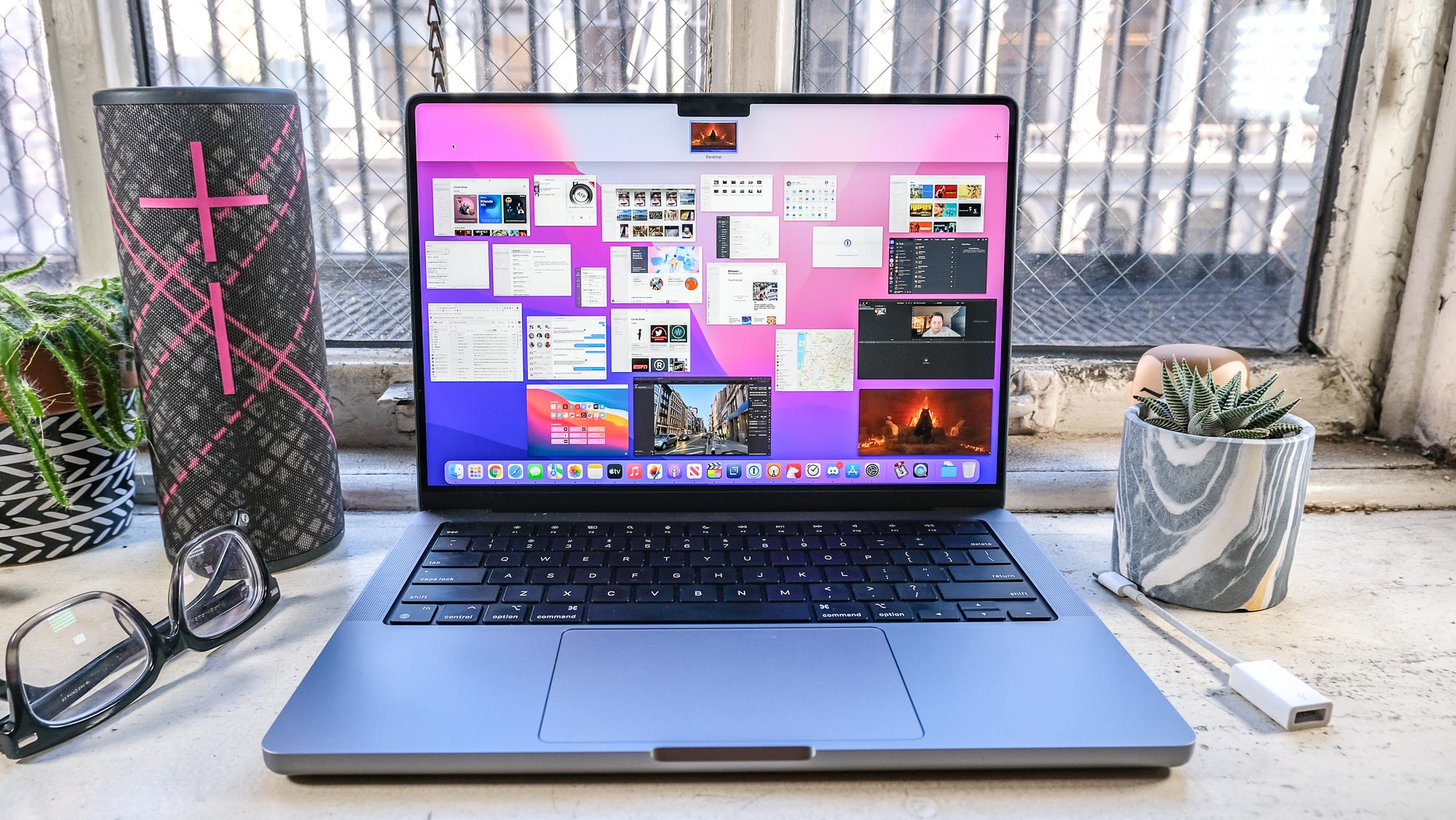MacBook Pro 2021 benchmarks — how fast are M1 Pro and M1 Max?

Apple revealed its M1 Pro and M1 Max chips when it unveiled the new MacBook Pro 2021 (14-inch) and MacBook Pro 2021 (16-inch) laptops during the Apple Unleashed event.
The company boasted about the power of the Apple silicon processors and made direct comparisons to PC laptops, to the extent that even non-Apple fans took notice of the raw power these new M1 processors supposedly possessed. On paper, the M1 Pro and M1 Max appear to be game-changers for the MacBook Pro line.
- Apple M1 Pro vs M1 Max: What’s the difference?
- Apple M1 Pro chip — everything you need to know
- Want to stay safer online? Grab yourself a Mac VPN
We now have numbers that prove the M1 processors are as powerful as we were led to believe.
We’ve pitted the MacBook Pro 2021 14-inch (M1 Pro 10-core GPU with 32GB of RAM) and the MacBook Pro 2021 16-inch (M1 Max 32-core GPU with 64GB of RAM) against three comparable laptops: the Asus ProArt StudioBook 16, HP ZBook Fury 17.3-Inch G8, and Microsoft Surface Laptop Studio. Both the ProArt StudioBook and Surface Laptop Studio have 32GB of RAM, while the ZBook Fury has 64GB.
For good measure, we also compared it to last year's MacBook Air M1 and MacBook Pro M1 to give you a sense of how the new M1 chips stack against their predecessors.
MacBook M1 Pro and M1 Max: Performance benchmarks
On the Geekbench 5.4 multi-core test, the M1 Pro and M1 Max scored 12,477 and 12,683, respectively. These scores obliterate the Microsoft Surface Laptop Studio’s 5,820 and handily surpass the Asus ProArt StudioBook 16’s score of 9,158 and the HP ZBook Fury’s 9,716. The M1 MacBook Air (5,962) and M1 MacBook Pro (5,925) can’t compete, either.
| Header Cell - Column 0 | Geekbench 5.4 | Handbreak video transcoding | PugetBench Photoshop |
|---|---|---|---|
| MacBook Pro 14-inch M1 Pro | 12,477 | 4:51 | 806 |
| MacBook Pro 16-inch M1 Max | 12,683 | 4:48 | 877 |
| Asus ProArt StudioBook 16 | 9,158 | 6:06 | DNR |
| HP ZBook Fury G8 | 9,716 | 6:27 | 1,077 |
| Microsoft Surface Laptop Studio | 5,820 | 11:24 | DNR |
| MacBook Air M1 | 5,962 | 9:15 | 653 |
| MacBook Pro M1 | 5,925 | 7:44 | 649 |
The new laptops nab another win on our Handbrake video transcoding test. They convert a 4K film to 1080p at 4:51 and 4:48, respectively; this is nearly half the 11:24 taken by the Surface Laptop Studio. Both the M1 Pro and M1 Max MacBooks also beat the Asus and HP laptops in this category, but not by so much. They also outshine the MacBook Air M1’s 9:15 and the MacBook Pro M1’s 7:44.
Get instant access to breaking news, the hottest reviews, great deals and helpful tips.
Finally, we have the sole performance category where the new M1 Pro/Max laptops lose. On the PugetBench Photoshop test, the M1 Pro (806) and M1 Max (877) scored less than the ZBook Fury (1017). However, their respective times — 4:54 for the M1 Pro and 4:44 for the M1 Max — are comparable with the ZBook Fury’s 4:56. We don’t have Photoshop numbers for the Surface Laptop Studio or Asus ProArt StudioBook 16. However, both new laptops surpass the MacBook Air M1 (653) and MacBook Pro M1 (649).
MacBook M1 Pro and M1 Max: Gaming benchmarks
Gaming is one of the areas we expected the 2021 MacBook Pros to really shine. However, our tests reveal some surprising numbers. Sid Meier’s Civilization VI runs at 46 fps on the M1 Pro (at 1512x982p resolution) and 46 fps on the M1 Max (1728x1080). These numbers are marginally better than the 37 and 38 fps reached on the M1 MacBook Air and M1 MacBook Pro, respectively.
| Header Cell - Column 0 | Civilization IV: Gathering Storm (fps) | Resolution |
|---|---|---|
| MacBook Pro 14-inch M1 Pro | 46 | 1512 x 982 |
| MacBook Pro 16-inch M1 Max | 46 | 1728 x 1080 |
| Asus ProArt StudioBook 16 | 92 | 1920 x 1080 |
| HP ZBook Fury G8 | 83 | 1920 x 1080 |
| Microsoft Surface Laptop Studio | 66 | 1920 x 1080 |
| MacBook Air M1 | 37 | 1440 x 900 |
| MacBook Pro M1 | 38 | 1440 x 900 |
The new MacBooks cannot touch the whopping 92 fps achieved on the ProArt Studio Book 16 (1080p). Both the Surface Laptop Studio (66 fps) and ZBook Fury (83) also performed better. As I've said before, the MacBook Pro M1 Max is an absolute beast — and a complete waste for gamers.
MacBook M1 Pro and M1 Max: Battery life benchmarks
Battery life is jaw-dropping compared to the competition. The M1 Pro (14:08) and M1 Max (15:31) MacBooks lasted far longer than the ProArt StudioBook (6:16) and ZBook Fury (7:09). They also bested the Surface Laptop Studio’s best time of 12:03. Like the MacBook Air M1 (14:41) and MacBook Pro M1 (16:32) before them, the new 2021 M1-powered MacBook Pros have exceptional all-day battery life.
| Header Cell - Column 0 | Battery life |
|---|---|
| MacBook Pro 14-inch M1 Pro | 14:08 |
| MacBook Pro 16-inch M1 Max | 15:31 |
| Asus ProArt StudioBook 16 | 6:16 |
| HP ZBook Fury G8 | 7:09 |
| Microsoft Surface Laptop Studio | 10:42 (120Hz) |
| MacBook Air M1 | 14:41 |
| MacBook Pro M1 | 16:32 |
The M1 Pro and M1 Max-powered MacBook Pros are serious business, as revealed by our tests. Apple wasn’t joking when it said the new M1 chips are the company’s most powerful processors. Gaming performance is disappointing, but by every other measure, the new M1s outstrip the competition.

Tony is a computing writer at Tom’s Guide covering laptops, tablets, Windows, and iOS. During his off-hours, Tony enjoys reading comic books, playing video games, reading speculative fiction novels, and spending too much time on X/Twitter. His non-nerdy pursuits involve attending Hard Rock/Heavy Metal concerts and going to NYC bars with friends and colleagues. His work has appeared in publications such as Laptop Mag, PC Mag, and various independent gaming sites.
